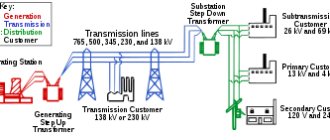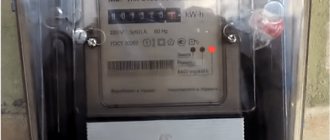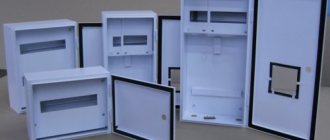Electricity metering is needed to extract the necessary information about the amount of energy and power consumed. Every year, professionals want to automate this process. They are trying to make it less labor-intensive, but at the same time more reliable. This process led to the introduction of the latest modern system ASTUE or automated system for technical accounting of electricity.
Electricity technical metering system
ASTUE (electricity metering system) eliminates labor costs and the human factor, which contributes to both the creation of an erroneous incident and the correction of errors in automated production. Automation creates additional opportunities related to monitoring, assessing the health status of the accounting system, and identifying faults. In addition, the system ensures safety and long-term storage of the received data.
ASTUE transcript
ASTUE is an Automated System for Technical Accounting of Energy Resources for monitoring the process of energy consumption within an enterprise across its divisions (shops) and facilities.
As a rule, an enterprise needs to carry out online monitoring of various types of energy. The most common types of ASTUE are:
- technical energy metering (multi-metering);
- technical accounting of thermal energy;
- technical accounting of electricity at the enterprise;
- ASTUE based on pulse telemetry output;
- technical accounting of water.
In addition to ASKUE and ASTUE, we build light control systems, heat, water, and gas dispatch systems.
LLC "European System Technologies" has 17 years of experience in the energy metering market, building automated accounting systems, automated accounting systems, automation of technological processes, automation of business processes, development of custom software.
We have dealers and sub-branded suppliers of equipment and software in the Republic of Belarus, the Russian Federation, Kazakhstan and other CIS .
We are ready to build you any automated system cheaper and better than any analogues that you provide.
System Performance Requirements
Performance.
- the ability to output data to the telemechanics system;
- control over operating parameters of power supply from electricity metering devices;
- ensuring the collection of data from all electrical metering devices installed in high-voltage switchgears;
- ensuring data transmission via all communication channels;
- must have communication with other control systems on controllers and devices.
Reliability.
- conducting round-the-clock collection, formation, processing and archiving of data;
- the system should not perform spontaneous actions to turn on or off working machines or switch to backup power;
- have software that is protected from unqualified and unprofessional intervention by maintenance personnel, which can lead to incorrect changes in the technological regime;
- ensuring operability in case of power loss for 30 minutes.
Connection diagram for meters of the ASTUE system in cells (feeders) at a 35/10 kV transformer substation
The system functions include:
- display of the real state of communication with all controlled objects;
- comparison of parameters and calculated characteristics of various numbers of similar objects;
- implementation of a system based on a client-server architecture with protection against power failures
- provide access via WEB interface;
- must be compatible with standard operating systems and flexibly integrated with existing software;
- must make maximum use of the capabilities of telemechanics;
- ensure reliable operation with scheduled stops for maintenance no more than 2 times a year;
- ensure information security of stored materials.
ASTUE and ASKUE difference
In this case, ASKUE is accounting only in the technical sense “for oneself” (without settlements with suppliers), and ASKUE is commercial accounting, according to which settlements with energy suppliers are carried out.
Commercial metering has an established energy supply scheme and is a closed system, changing the structure of which is impossible without agreement with the energy supply organization. As a rule, when developing an ASKUE project, online commercial accounting systems are laid out.
Technical accounting, on the contrary, is constantly evolving, reflecting the changing requirements of production; it is characterized by a large number of metering points with different tasks for controlling energy resources. Technical accounting is necessary to create effective zone control over the consumption of fuel and energy resources in the context of objects (workshops, sites, base stations) in real time and reduce the cost of fuel and energy resources per unit of production. In the future, any enterprise and organization is interested in creating a single information space for monitoring production and management processes online.
Not only the equipment and software, but also the volume of commissioning work performed, as well as the cost of the entire project, depends on the type of accounting that you plan to organize.
At the request of the client, European System Technologies LLC (or its partners) implements ASKUE on a turnkey basis, which implies the following set of works:
- Site inspection;
- ASKUE design;
- Supply of ASKUE equipment and software;
- Commissioning (installation of ASKUE, configuration of ASKUE);
- Commissioning of the ASKUE system into commercial operation;
At the initial stages of the project to create a commercial or technical accounting system, our specialists will determine the optimal configuration and, together with you, develop a technical specification for creating the type of accounting you need.
Our main task is to offer an individual version of the energy metering system with high quality and at an affordable price for you.
What is an “automated workstation” (AWS)
An automated workstation is a mandatory component of ASTUE. Thanks to it, you can regularly record readings and create graphs for a detailed analysis of an entire enterprise or any specific chain of activities connected to the network.
Using such graphs, you can track energy consumption over time and even make a forecast for the future consumption of specific devices.
Such software is extremely necessary for large enterprises, which are required to draw up a plan for further activities and timely submit applications for a certain amount of electricity to the relevant electricity supply organizations.
Software product for building ASKUE, ASTUE
Saving electricity (heat, water, gas) is achieved in the case of the introduction of ASKUE at the enterprise by reducing losses of energy resources, as well as changing the operating mode of equipment and personnel.
The ASKUE system also allows you to create a reliable information and technical base in order to ensure increased energy efficiency and a set of energy saving measures.
To organize an ASKUE system at an enterprise, it offers a software product eMaxTools , which allows enterprise management to monitor online quantitative indicators of the share of the cost of energy resources in a unit of finished products. In this case, the enterprise receives a tool to reduce energy consumption in the consumption structure of production costs and increase the profit of the enterprise.
Scope of application of the automated electricity metering system:
- Automated accounting of electricity consumed for various needs (consumption for individual industries, workshops, sections, individual types of products, etc.);
- Electricity consumption planning;
- Backup of commercial electricity metering data (replacement of commercial metering system data);
- Identification of irrational use of electrical energy (consumption control based on statistical data);
- Reducing electricity losses based on analysis of accounting data;
- The ability to use electricity consumption data to analyze the financial and economic activities of an enterprise (use of electricity consumption data when calculating production costs, costs for business needs, etc.).
Software product for data collection and equipment management (including NBIoT)
Currently, we have developed a unique proposal for building any dispatching and telemechanics systems, both using conventional communication means for instrumentation and automation, and using the new NBIoT , which allows us to qualitatively improve the range of an object and reduce the cost of maintaining such equipment. In addition, we can manage equipment over NBIoT . Please check out our new universal software product “My Client: Resources”.
Principle of operation
The ASTUE system contains two main complexes: information and computing.
The design of the first complex includes all kinds of voltage and energy transformers that measure these parameters. The second complex includes lines through which readings from metering devices are transmitted to the computer. The system includes a series of steps that depend on the degree of significance. The lowest level contains measuring instruments such as electricity meters and measuring generators. Medium-value devices include devices that collect and transmit readings, as well as all kinds of communication means. The highest level of the system is occupied by the equipment through which the software is implemented.
The values of electricity meters are recorded simultaneously throughout the entire system, at set time intervals. These readings of each time period are transmitted via a transmission channel to the server, where they are stored.
The system design includes highly intelligent metering devices equipped with built-in memory and an interface for sending data to the server. Some models of electricity meters are equipped with built-in modems and are capable of independently sending readings at a set time via a telephone line or radio communication. For the system to operate effectively, all components must be set to the same time.
Key Features
The ASKUE system cannot function normally without digital electricity and power metering devices, communications, computers, and software. The collection and transmission of information occurs thanks to microprocessor devices that are located in a certain sector. The main advantages of such units include the ability to take into account active and reactive energy in accordance with the current tariff. The equipment calculates the power indicator in all directions.
The system is designed to record the load in a certain time period and the maximum load; all information is stored in the ASKUE memory. Some devices are capable of measuring quality parameters of electricity: voltage dips, frequency. The transfer of all collected information can only take place if a connection has been established. Otherwise, the data will be archived in kilowatt-hours. Such information can be stored in the memory of the metering device for some time.
Communications are represented by specialized telephone channels, as well as telecommunications equipment (multiplexers, modems, radio modems). The final works always depend on computers. To automate the process, specialists have developed universal interfaces for transmitting collected information:
- Pls. All data is transmitted via the meter's power wires.
- RS-485 interface. The system is presented in the form of a cable that supports the connection of up to thirty devices. Thanks to this, specialists can increase the data transfer speed several times. But this option is only suitable for small objects.
- Mobile interface. Information can only be transmitted using a high-quality modem.
Particular attention should always be paid to the software, since this is what allows exchange with other suppliers and enterprises.
Types of ASKUE
Since electricity prices are constantly rising, experts are trying to develop new effective metering measures in a timely manner. Due to this, the scope of application of universal automated control systems is constantly expanding. The introduction of new technologies helps to effectively and continuously control and optimize the amount of costs. Statistics have shown that automated accounting systems are used in the following industries:
- In residential sectors, private and commercial real estate.
- Collective accounting systems that allow you to service up to 50 subscribers.
- Consumer industries.
- Large systems serving up to 1 thousand people.
- In country houses and dachas, as well as in gardening partnerships.
The main part of information and measurement systems is based on a computer complex installed in individual accounting sectors, as well as processing various information at substations, oil and gas organizations, power plants, as well as at large manufacturing and industrial enterprises.
Tools and materials
Replacing or installing a new electric meter yourself will require the use of special tools:
- comfortable pliers with rubberized handles;
- a set of non-conductive screwdrivers;
- sharp knife for stripping insulation from wires;
- insulating materials;
- measuring multimeter.
Types of electric meters may differ in their fixation methods, so it is necessary to purchase not only wires with a certain cross-section, insulators and RCDs with circuit breakers, but also fasteners and a current transformer. Installation is carried out in the subscriber panel using mounting strips.
What are the advantages of ASKUE compared to traditional energy metering?
An automated system for commercial electricity metering allows you to ensure the accuracy and transparency of mutual settlements between suppliers and consumers, and also implements:
- accurate measurement of energy supply and consumption parameters;
- continuous automatic collection of data from metering devices with sending to the server and visualization in your personal account;
- monitoring energy consumption at specified time intervals;
- continuous accumulation and long-term storage of data even when the power supply to the metering devices is turned off;
- quick diagnostics of data with the ability to download information for the current and previous periods;
- analysis of the energy consumption structure with the possibility of its adjustment and optimization;
- prompt identification of unauthorized connections to the energy supply network or unmetered consumption;
- recording even minor deviations of all monitored parameters;
- the ability to predict energy metering values for short-, medium- and long-term periods;
- remote disconnection of consumers from the network with the possibility of switching back on.
As a consequence of the above factors, the introduction of ASKUE contributes to energy saving, due to which the system pays for itself on average within one year.
It's time to introduce a remote method of taking meter readings and automated data processing. For this, resource supply organizations have every opportunity.
Alexander Varfolomeev, Deputy Chairman of the Federation Council Committee on Social Policy
Thus, the Russian Government clearly answers the question of whether ASKUE is needed. The problems that it leaves for electricity suppliers, industrial consumers, management companies and homeowners' associations boil down to choosing the optimal equipment for its design and implementation.
From the point of view of the possibilities for optimizing accounting and energy consumption provided by ASKUE, the system has practically no disadvantages. They, of course, exist, and are associated with its specific embodiment. Thus, the main disadvantages of installing a wired ASKUE system are the high cost and the risk of network failure. Among the disadvantages of wireless solutions based on GSM protocols, we should highlight the need to install a SIM card in each metering device, the high cost of modems, and signal instability when placing meters inside reinforced concrete buildings or metal cabinets.
These problems are eliminated by solutions for “smart homes” based on ZigBee, M-Bus and Z-Wawe, however, their range of action (up to 50 m) requires the connection of additional repeaters, which increases the cost of installing ASKUE and, accordingly, its payback period.
As the analysis and comparison of modern energy metering automation technologies shows, the most cost-effective solution for implementing ASKUE is LPWAN technology. An automated system built using this technology does not require additional equipment: each metering device is simultaneously a device for collecting and transmitting data (the middle level of the ASKUE structure). At the same time, its cost is not much higher than the retail price of a conventional smart meter with similar characteristics.
The STRIZH system uses LPWAN technology with a range of 10 km, without concentrators and repeaters.
Electricity metering automation system for MKD, RSO and SNT
Continuing the article:











